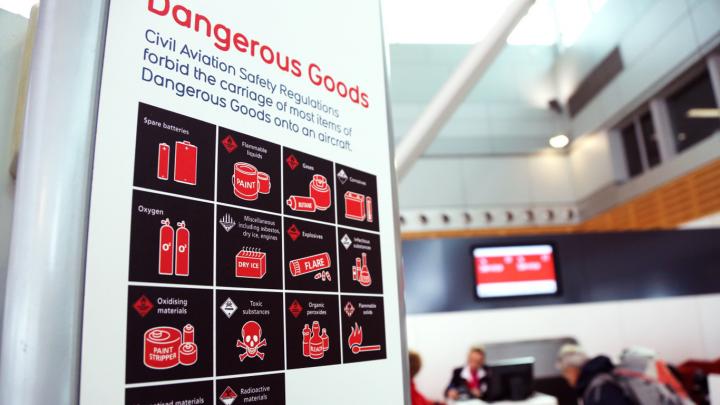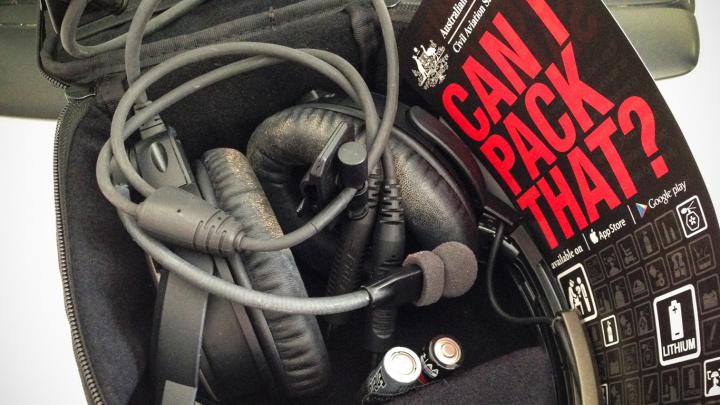Types of dangerous goods
But what about those 'harmless' aerosols and spare batteries you’ve thrown into your bag? Can you head outback with the can of mozzie repellent onboard?
Some of the common and potentially dangerous items on scheduled air transport aircraft in Australia include:
- lost and damaged smartphones (for example, incidents where a passenger has lost their phone, reclined their seat damaging the phone’s battery, and starting an in-flight fire)
- spare batteries and portable power packs
- chainsaws, whipper snippers and other devices with internal combustion engines
- hoverboards
- gas cylinders and camping stoves
- paint and paint-related products
- nail polish remover (acetone)
- fireworks
- compressed oxygen
- lighters and matches
- items that contain mercury.
Many pilots will encounter 4 main types of DG:
- DG which are part of the aircraft's operating equipment (tyres, batteries, fire extinguishers, fuel, agricultural spray, feral animal baits etc.).
- Replacements for aircraft equipment (fuel control units, carburettors, batteries, damaged tyres).
- Passengers carrying DG.
- DG pilots don’t know about.
Our DG Inspectors have investigated many DG occurrences over the decades. The most dangerous of goods are those you don’t know about. These include:
- chemical leakage
- fires
- spontaneous and rapid disassembly coming from hidden and undeclared DG.
Visit the Pack Right. Safe Flight. website to find information about:
- aerosols
- camping equipment
- fuel cell systems
- lithium batteries
- thermometers.
Dangerous goods poster
Batteries and portable power packs
Many devices have self-contained batteries and need charging.
There are many types of batteries. Batteries pilots use for equipment like headsets do not store the high amount of energy that a lithium battery does.
While passengers can carry spare lithium in baggage, many Australian airlines require you to carry all spare batteries in the cabin.
Lithium batteries bring a different set of challenges. Lithium metal non-rechargeable batteries are usually very stable and have a long shelf-live but will burn with devastating effect in a fire.
Small and flat lithium button cells you found in watches and hearing aids are far more benign.
Lithium-ion rechargeable batteries tend to be more volatile and can become unstable under certain conditions.
Don’t pack any battery that looks unhealthy. For example, if your batteries are:
- bulging
- show discolouration
- split case
- leaking fluid.
There are number of things you can do to reduce the risk of travelling with rechargeable batteries. When traveling you should:
- avoid recharging or discharging your batteries just prior to departure
- take them at a 30 to 50% state of charge
- not leave them in a hot car or aircraft cockpit.
Learn more about batteries and portable power packs.
Aerosols
DG regulations limit flammable aerosols to medicinal or toiletry articles.
Examples include:
- hair sprays
- colognes
- deodorants
- shaving foam
- personal disinfectant (hand sanitiser)
- personal insect repellent.
A good rule of thumb is if you would spray it on your body, you can probably travel with it.
Things you wouldn’t put on your body you may not be able to travel with. This can include:
- window cleaner
- fly spray
- furniture polish.
You can carry non-flammable propellant.
Headphones in a case with Can I pack that? reference card
Private pilots
Part 92.175 of the Civil Aviation Safety Regulations relates to goods carried by private operators.
This regulation permits aircraft owners and private operators a lot more flexibility when carrying DG.
Private operators can assess the risk presented by the DG that they intend to carry and make a decision based on their judgement.
Private operators need to consider whether the proposed carriage of DG is safe.
If you are hiring the aircraft, you should check on the aero club, owner or operator policy.
An owner may prohibit certain items and their insurer's policy may not cover incidents arising from DG.
Things to remember during an emergency
After you've done all your preparation in carrying DG, also think through what you'll do in an emergency.
Communicate those action plans to the passengers and think about the actual emergencies. For example:
- engine failure
- engine fire
- fire in the cabin
- potential emergencies such as noticing fuel or gas fumes.
For the private pilot, CASR 92.175 rule gives you flexibility in carrying DG.
Always think about the risks and how you can reduce them.
If you think and plan carefully ahead and apply some common sense and caution, you won’t have to put your emergency drills into practise. You also won’t have to have an awkward conversation with your insurer.
Fly safely and have fun.



